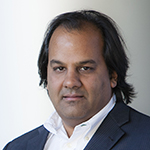Vision for the Future of Lung Health
May 2016

Atul Malhotra, MD
The ATS has achieved a lot in the last few years; I am grateful to the executive committee and all of the staff and volunteers who made great things happen. In thinking about future priorities, a few ideas come to mind, some of which may not be easy to achieve but I hope this provides food for thought:
- Air pollution. Recent data have shown that air pollution affects the growth of our children’s lungs as well as their neurocognitive function and development. I used to be somewhat blasé about issues around air pollution and usually refrained from conversations about global warming due to my own lack of expertise in this area. However, with definitive data now showing major cardiopulmonary risk from air pollution, I do not think we can ignore this issue any more in good conscience. The problems are particularly bad in developing countries, but the issue is really a global one. Accelerating our efforts to implement clean energy strategies for the sake of our patients and our kids should be a priority. At a recent meeting in Kyoto, Japan, we developed consensus among sister professional organizations in the Asia Pacific region to make improvements in air quality an ongoing focus, and we agreed to work towards creating a global consensus around this issue. I understand and support the importance of economic growth and development but not at the expense of our children’s lungs.
- Cigarette smoking. During my ATS travels, I have been surprised by the high prevalence of smoking even among physicians in China, India, and other countries. We are now seeing a surge in the use of e-cigarettes, which to my mind is trading one epidemic for another. This problem will be easier to fix now rather than later, and aggressive education through mass media, as well as strategic taxation, might help prevent us from creating another generation of addicts. Government subsidies for tobacco crops should stop. Proportionate funding: Lung research receives a disproportionately low percentage of research funding, in part because of a perception that lung diseases are self inflicted. At present, the majority of COPD worldwide is non-smoking related, caused by cook stoves, air pollution, and other factors. Thus, blaming the victims of lung diseases is irresponsible and inaccurate. The majority of patients with COPD die from either cancer or heart disease, but these deaths are rarely attributed to the underlying pulmonary cause. Lung cancer is the number one cause of cancer death in both men and in women. ARDS is a leading cause of death in the U.S., but is rarely recognized as such. McKenzie Consulting estimated that sleep apnea has more than $50B in direct health care costs per year, but is still frequently overlooked by practitioners and by funding agencies. Despite major progress in pulmonary research, we are only beginning to understand the biology of the respiratory system. Thus, redoubling our efforts to cure lung diseases is likely to bear fruit in the coming years. Such efforts will occur through adequate funding that meets the scope of the problem.
- Pharma-physicians. I am highly supportive of academic/industry interactions and have many close friends, colleagues, and collaborators who are in industry. At present, academics put considerable effort and revenue into the training of students, residents, and fellows. These individuals provide the majority of the pipeline into industry-related science. Yet to my knowledge, the contribution of industry to training of their intellectual pipeline is quite minimal. Many models could be considered whereby industry contributes to this pipeline or perhaps shares this risk and burden in the development of “pharma-physicians.” Clearly, conflicts of interest would need to be managed as appropriate (e.g. training would need to be focused on general disciplines and not product-specific).
I realize that each of these issues is complex, and there are no quick fixes. However, I do think these challenges warrant discussion and would like to see a vision for progress in the next decade.
Last Reviewed: September 2017

